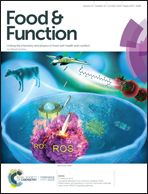Comparison of berry juice concentrates and pomaces and alternative plant proteins to produce spray dried protein–polyphenol food ingredients
Abstract
Spray dried functional food ingredients were prepared by complexing alternative plant protein sources – buckwheat flour alone or blended with pea and rice proteins, with polyphenol sources – blueberry, cranberry and purple muscadine grape extracts from juice concentrates and pomaces – to create colloidal aggregate powders. When fruit pomaces (rather than juice concentrates) were used as polyphenol resources, solid recovery was significantly enhanced, especially for matrices made with pea protein, buckwheat flour or pea–buckwheat blends (over two fold for pea protein–berry pomace aggregates). Polyphenol content and DPPH radical scavenging capacity were, in general, significantly greater for pomace-derived protein–polyphenol aggregates compared to those made with juice concentrates. In particular, the particles produced with muscadine grape pomace presented the highest (p < 0.05) phenolic content (147.3–174.3 mg g−1, 19.4–20.4 mg g−1 and 16.3–21.4 mg g−1 for total phenolic content, anthocyanins and proanthocyanidins respectively), and antioxidant activity (408.9–423.3 μmol TE per g) as well as good spray drying yield (38.6–63.4%). Buckwheat flour, despite its relatively low protein content (13.7%) relative to pea and rice protein isolates (84% and 89%, respectively) still demonstrated high capacity for sorption of flavonoid phytoactive compounds from the berry fruits. These results suggest an efficient plant-based approach to produce value-added protein–polyphenol aggregates with broad utility as healthy food ingredients.

- This article is part of the themed collection: Berry Health Benefits Symposium


 Please wait while we load your content...
Please wait while we load your content...